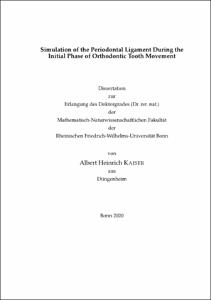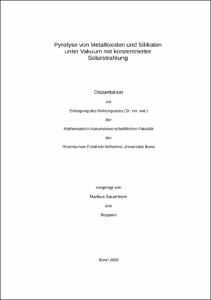Simulation of the Periodontal Ligament During the Initial Phase of Orthodontic Tooth Movement

Simulation of the Periodontal Ligament During the Initial Phase of Orthodontic Tooth Movement

| dc.contributor.advisor | Bourauel, Christoph | |
| dc.contributor.author | Kaiser, Albert Heinrich | |
| dc.date.accessioned | 2020-09-22T13:16:08Z | |
| dc.date.available | 2020-09-22T13:16:08Z | |
| dc.date.issued | 22.09.2020 | |
| dc.identifier.uri | https://hdl.handle.net/20.500.11811/8613 | |
| dc.description.abstract | The present work is concerned with the simulation of the periodontal ligament response to force in the initial phase of orthodontic tooth movement. This is based on two previous investigations at the Universitätsklinikum Bonn, namely the in vitro experiment of Papadopoulou et al. (2013) with specimens of porcine mandibular premolars, and the in vivo experiment of Konermann et al. (2017) on human upper first incisors.
For the curve fit of the in vitro experiment a model function, assuming viscoelasticity, was introduced. The viscoelastic model function was augmented by a ramp rise time term, to account for observed dependence of the response on actuator velocity, and a previous load history term, to account for the effect of the previous tests on the current test. The correlation coefficient of a curve fit for all tests grouped together was R²=0.98. Next, a curve fit of the in vivo experiment was done. Good correlation was found for a simplified model function, without viscoelastic term. Presumably due to the short test duration viscoelastic effects were not evident. For both tests, in vitro and in vivo, the ramp rise time term improved correlation. The finite element model of Papadopoulou et al. (2013) was adapted for this investigation. The present work indicates that the macroscopic response of the periodontal ligament to an external load can be simulated with a poro-visco-hyperelastic model. For the hyperelastic model of the ground substance, Storåkers (1986) constitutive model was used, and parameters identified herein are in good agreement with values published in Bergomi et al. (2011). The simulation showed that poroelastic behaviour will gradually cease when viscoelastic relaxation progresses. This followed also from dimensionless analysis. As a consequence, for slow loading, or if initial response to fast loading is not of interest, a visco-hyperelastic model may suffice. The curve fit of the model function conceived herein is in good agreement with measured data. The model function includes a ramp rise time term, which could not be covered with the poro-visco-hyperelastic simulation. A supposition to explain this effect on the micro scale is to assume strain rate hardening. For soft tissues strain rate effects were observed by other investigators, e.g. David Bell et al. (2018) and Burgin et al. (2014), however the underlying microstructural mechanism is still unknown. Papadopoulou et al. (2013) did not randomise the test sequence with respect to ramp rise time. Therefore, it can not be excluded that the effect is due to test sequence. To clarify this objection, further tests with randomised test sequence are recommended. | en |
| dc.description.abstract | Simulation des Periodontiums in der ersten Phase einer orthodontischen Zahnbewegung In dieser Arbeit wird die Simulation der Reaktion des Periodontiums auf äußere Kräfte in der ersten Phase einer orthodontischen Zahnbewegung behandelt. Dies basiert auf In-vitro-Versuchen von Papadopoulou et al. (2013) an Proben des Prämolars von Schweinen und In-vivo-Untersuchungen von Konermann et al. (2017) an menschlichen Schneidezähnen. Für die Regression der In-vitro-Daten wurde eine Modellfunktion eingeführt, die viskoelastisches Verhalten beschreibt. Diese wurde durch zwei Ausdrücke erweitert. Der erste beschreibt eine Abhängigkeit von der Geschwindigkeit des Aktuators, der zweite den Einfluss vorangegangener Tests auf den aktuellen Test. Eine Regression aller Tests ergab den Korrelationskoeffizient R²=0,98. Anschließend wurde eine Regression der In-vivo-Daten durchgeführt. Eine gute Korrelation wurde für eine vereinfachte Modellfunktion ohne Viskoelastizität gefunden. Vermutlich waren viskoelastische Effekte aufgrund der kurzen Testdauer nicht erkennbar. Für beide Versuche, in vitro und in vivo, verbesserte der Ausdruck für die Geschwindigkeit des Aktuators die Korrelation. Das Finite-Elemente-Modell von Papadopoulou et al. (2013) wurde angepasst. Die vorliegende Arbeit zeigt, dass die makroskopische Reaktion des Periodontiums auf eine externe Last mit einem poro-visko-hyperelastischen Modell simuliert werden kann. Für das hyperelastische Material wurde das Modell von Storåkers (1986) verwendet. Die hierfür gefundenen Parameter stimmen gut mit den Werten von Bergomi et al. (2011) überein. Die Simulation zeigt, dass poroelastisches Verhalten ausklingt, wenn viskoelastische Relaxation fortschreitet. Dies lässt auch eine dimensionslose Analyse erwarten. Daher kann für eine langsame Belastung, oder wenn die anfängliche Reaktion auf schnelle Belastung nicht von Interesse ist, ein visko-hyperelastisches Modell ausreichen. Die Modellfunktion beinhaltet einen Ausdruck der eine Abhängigkeit von der Geschwindigkeit des Aktuators beschreibt. Dieser Effekt konnte nicht mit der poro-visko-hyperelastischen Simulation abgedeckt werden. Eine mögliche Erklärung ist dehnratenabhängige Verfestigung. Auch David Bell et al. (2018) und Burgin et al. (2014) haben dehnratenabhängig Effekte an biologischen Geweben beobachtet, die zugrundeliegenden mikro-mechanischen Mechanismen sind noch unbekannt. Die Versuchsreihe von Papadopoulou et al. (2013) wurde nicht bezüglich der Geschwindigkeit des Aktuators randomisiert. Daher kann ein Sequenzeffekt nicht ausgeschlossen werden. Um diesen Einwand auszuräumen, werden Versuche mit randomisierter Test Sequenz empfohlen. | en |
| dc.language.iso | eng | |
| dc.rights | In Copyright | |
| dc.rights.uri | http://rightsstatements.org/vocab/InC/1.0/ | |
| dc.subject | Biomechanik | |
| dc.subject | Ersten Phase - Orthodontische Zahnbewegung | |
| dc.subject | Periodontium | |
| dc.subject | Test und Simulation | |
| dc.subject | Poro-Visko-Hyperelastische Simulation | |
| dc.subject | Parameteridentifikation | |
| dc.subject | Dehnratenabhängige Verfestigung | |
| dc.subject | biomechanics | |
| dc.subject | periodontal ligament (PDL) | |
| dc.subject | initial phase of orthodontic tooth movement (OTM) | |
| dc.subject | test and simulation | |
| dc.subject | poro-visco-hyperelastic simulation | |
| dc.subject | Storåkers constitutive model | |
| dc.subject | parameter identification | |
| dc.subject | reduced order model | |
| dc.subject | optimum interpolation meta-model | |
| dc.subject | strain rate hardening | |
| dc.subject.ddc | 004 Informatik | |
| dc.subject.ddc | 610 Medizin, Gesundheit | |
| dc.title | Simulation of the Periodontal Ligament During the Initial Phase of Orthodontic Tooth Movement | |
| dc.type | Dissertation oder Habilitation | |
| dc.publisher.name | Universitäts- und Landesbibliothek Bonn | |
| dc.publisher.location | Bonn | |
| dc.rights.accessRights | openAccess | |
| dc.identifier.urn | https://nbn-resolving.org/urn:nbn:de:hbz:5-59200 | |
| ulbbn.pubtype | Erstveröffentlichung | |
| ulbbnediss.affiliation.name | Rheinische Friedrich-Wilhelms-Universität Bonn | |
| ulbbnediss.affiliation.location | Bonn | |
| ulbbnediss.thesis.level | Dissertation | |
| ulbbnediss.dissID | 5920 | |
| ulbbnediss.date.accepted | 08.07.2020 | |
| ulbbnediss.institute | Mathematisch-Naturwissenschaftliche Fakultät : Fachgruppe Informatik / Institut für Informatik | |
| ulbbnediss.fakultaet | Mathematisch-Naturwissenschaftliche Fakultät | |
| dc.contributor.coReferee | Klein, Reinhard |
Dateien zu dieser Ressource
Das Dokument erscheint in:
-
E-Dissertationen (4369)







